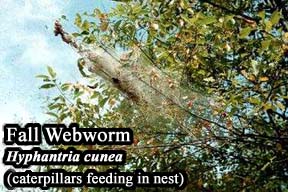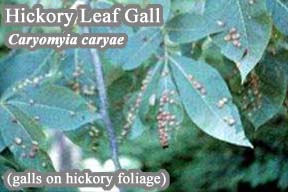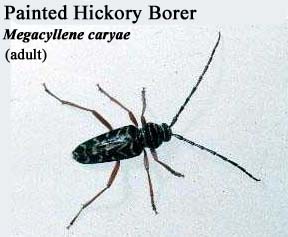Hickory
Diseases caused by Fungi:
Canker, Poria spiculosa.
This is the most serious disease of all of the hickories. Cankers form around dead branch stubs. These stubs appear to be nearly healed but brown fungus threads may be found in them, and thick, deep callus folds appear and cankers develop as rough circular swellings with depressed centers. This wood-rotting fungus will eventually spread through the tree.
No control is known, but cleaning and scraping the canker and removal of all discolored wood may help. Fertilize trees in the spring and water well during drought to maintain tree vigor.
Anthracnose, Gnomonia caryae.
This disease causes irregular purplish or reddish-brown spots on leaves and these spots may merge to form irregular shaped blotches. Although significant defoliation may occur after cool, wet spring weather, this disease is usually not serious to the health of the tree.
Rake and dispose of fallen leaves to reduce the chance of infection in the following season. Fertilize trees in the spring and water well during drought to maintain tree vigor. Since this disease is usually not a serious problem for the health of the trees, chemical controls are usually not necessary.
Witches'-broom. Microstroma juglandis.
These are bundles of twigs or small branches, or even very large branches, which resemble a broom. Usually more of a problem in the south, witches' broom at the ends of branches shows most clearly in winter. New leaves in spring are light in color and have the white moldy fruiting phase of the fungus on the underside.
Destruction of broomed twigs and fallen leaves will help to control the problem.
Insect Problems:
Aphids.
Several species of aphids are found on hickory. Three species, Monellia carye, M. caryella, and M. costalis, are common on the leaves. A larger ash-gray aphid (Longistigma caryae) with triangular black spots on the thorax of the wingless forms occurs on twigs. The winged form has a solid black thorax. If control measures are needed, a spray of malathion or insecticidal soap, which are among the compounds registered for use against this pest in Connecticut, will control the aphids. Consult the label for dosage rates, safety precautions, and preharvest intervals.
Cigar casebearer, Coleophora serratella.
Larvae 1/5" long with a black head mine the leaves causing them to turn brown and drop prematurely. The insect overwinters in cigar-shaped cases averaging about 1/8" long. They may be seen on the twigs and branches. Adult brown moths emerge in the spring.
 Fall webworm, Hyphantria cunea.
Fall webworm, Hyphantria cunea.
The fall webworm commonly infests hickory trees. Webworms damage the leaves by both feeding and web-building. Webworms overwinter within cocoons located in protected places, such as crevices in bark or under debris and fences. Adult moths emerge in summer. They have a wingspan of about 1 1/4", and vary from pure satiny white to white thickly spotted with small dark brown dots. Females lay white masses of 400-500 eggs on the undersides of the leaves. The caterpillars hatch in 10 days, and all from the same egg mass live together as a colony. They spin webs that enclose the leaves, usually at the end of a branch, to feed upon them. After they have defoliated a branch, they extend their nest to include additional foliage. When caterpillars are mature, they leave the nest to seek a place to spin gray cocoons. The mature caterpillars are about 1 1/4" long with a broad dark brown stripe along the back, and yellowish sides thickly peppered with small blackish dots. Each segment is crossed by a row of tubercles with long light brown hairs. In Connecticut, there is one complete generation and a partial second one. In light infestations, the webworms can be controlled by pruning the nests and destroying them. In larger infestations, caterpillars can be controlled with foliar sprays of Bacillus thuringiensis, which are among the compounds registered for use against this pest in Connecticut. Consult the label for dosage rates and safety precautions.
Hickory bark beetle, Scolytus quadrispinosus.
This beetle is the most destructive enemy of hickory trees in Connecticut and breeds under the bark. In July, females make an approximately inch long, vertical tunnel in the inner bark and sapwood. In rows of pockets along each side, she deposits one egg per pocket. The grubs hatching from these eggs begin to tunnel at right angles to the parent gallery. The larval galleries, narrow at first, increase in width as the larvae grow. Those at the ends of the parent gallery diverge so as not to run into other galleries. Even a few such brood galleries may girdle the branch. They usually begin in the upper part of the tree. The adult is a small brown or black beetle, 1/5" long, with abdomen truncated at the apex and bearing four short spines. The beetles emerge in June and July through round holes resembling shot holes and eat at the bases of the leaf stems, causing many leaves to turn brown in July. Some drop and others hang on the trees. There is one generation each year. This pest does most damage to weak trees, especially when stressed by drought. Fertilizing and watering trees may help to avoid infestation. A trunk spray of carbaryl, which is among the compounds registered for use against this insect in Connecticut, may help by killing adults before they have a chance to lay eggs. Consult the label for dosage rates, safety precautions, and preharvest intervals.
Hickory gall aphid, Phylloxera caryaecaulis.
This aphid forms galls in June on leaf stems and new shoots. The hollow galls contain the young aphids. In July, aphids reach maturity and leave the galls, which turn black. The galls are globular and cause much distortion to the shoots. Eggs remain over winter in the old galls and in crevices of the bark. A spray just before the buds swell of malathion or insecticidal soap, which are among the compounds registered for use against this pest in Connecticut, is a satisfactory control.
Hickory horned devil, Citheronia regalis.
The appearance of the larva suggests the common name of this insect. It may reach a length of more than 5" and varies in color from green to reddish brown. There are two large black spots on the second thoracic segment and short black spines on each segment with longer black-tipped "horns," near the head. It is never sufficiently abundant to be considered a pest, but occasionally it feeds on the leaves of hickory and other trees. The adult is called the regal moth and is one of our largest and most beautiful moths with a wingspread of 5 to 5 1/2". The forewings are taupe gray with light red along the veins, with a number of oval buff spots. The rear wings are light red with buff spots. Sprays of carbaryl, malathion, or Bacillus thuringiensis var. kurstaki, which are among the compounds registered for use against this pest in Connecticut, should control this caterpillar. Consult the label for dosage rates, safety precautions, and preharvest intervals.
 Hickory leaf galls.
Hickory leaf galls.
There are several insect galls on hickory leaves, most of them caused by midges or flies. Some of the more common are the hickory tube gall, Caromyia tubicola, the hickory seed gall, C. caryaecola, the hickory onion gall, C. holotricha, the hickory peach gall, C. persicoides and the hickory leaf gall, C. carye. These galls are seldom destructive enough to require control.
Hickory leaf roller, Argyrotaenia juglandana.
The larva is yellowish green, about 1" long, and rolls hickory leaves in a characteristic manner and feeds on them inside the rolls. The moth is dark brown with darker oblique bands on the forewings. It has not been a serious pest. If necessary, malathion, Bacillus thuringiensis var. kurstaki, which is among the compounds registered for use against this pest in Connecticut, can be applied in the spring for control. Consult the labels for dosage rates, safety precautions, and, where applicable, preharvest intervals.
Hickory tussock moth, Lophocampa caryae.
This insect feeds on hickory and other tree foliage. The full-grown larva is about 1 1/2" long, covered with white hairs, with a stripe of black hairs along the back, and two narrow pencils of black hairs at each end. The adult moth has a wingspread of about 2", with forewings light brown marked with oval white spots and darker brown veins. The rear wings are light buff. The eggs are laid in patches on the underside of a leaf in July. There is one annual generation, and the insect overwinters in gray cocoons fastened to trees, fences, or other objects. Spraying with Bacillus thuringiensis var. kurstaki or malathion, which are among the compounds registered for use against this pest in Connecticut, gives control. Consult the labels for dosage rates, safety precautions, and, where applicable, preharvest intervals.
 Painted hickory borer, Megacyllene caryae.
Painted hickory borer, Megacyllene caryae.
The larva of this beetle tunnels under the bark and in the sapwood of hickory. The beetles emerge in May and June and there is one annual generation. The beetle is about 3/4" long, blackish with yellow markings. There are three narrow cross-bands on the thorax, a W-shaped mark across the wing covers near their base, and several other wavy cross-marks. Eggs are laid in crevices or under the edges of the bark and the young larvae tunnel partly in the bark and partly in the wood. Larvae become mature in 10 to 12 weeks, pupate in the wood in September and overwinter there.
Healthy trees are seldom injured by this insect, so maintain adequate irrigation to trees. Cutting and burning infested trees and all slash, if allowed, is the usual measure of control. A trunk spray of carbaryl, which is among the compounds registered for use against this insect in Connecticut, may help by killing adults before they have a chance to lay eggs. Consult the label for dosage rates, safety precautions, and preharvest intervals.
Walnut caterpillar, Datana integerrima.
The walnut caterpillar feeds on hickory. This caterpillar is usually noticed in August when clusters of black caterpillars with whitish hairs are found stripping the branches of walnut and hickory. On the trunks and larger branches, gray hairy patches can be seen where the groups of caterpillars have molted or cast their skins. The mature caterpillars are about 2" long, black, and covered with whitish hairs. The adult moth has a wingspread of about 2", is light reddish brown, and darker reddish lines cross the forewing. The thorax has a bright mahogany-red spot. The moths emerge in July and lay clusters of eggs on the undersides of the leaves. The caterpillars become mature in September, pupate in the ground, and remain there until the moths emerge the following season. There is only one generation each year. On small trees, the caterpillars may be gathered and crushed. Carbaryl, malathion, or Bacillus thuringiensis var. kurstaki, which are among the compounds registered for control of this pest in Connecticut, can be applied as sprays if caterpillars are numerous. Consult the labels for dosage rates, safety precautions, and preharvest intervals.

